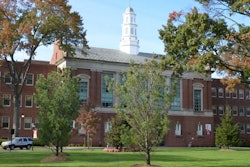Changing student demographics may prove the most formidable ever for American colleges and universities as well as for public K-12 school systems, scholars say.
Scholars at the Tómas Rivera Policy Institute at the University of Southern California have pointed to the precedent of European immigration in the latter years of the 19th century and the early years of the 20th century to describe the challenges that lay ahead for U.S. K-12 and higher education. The institute recently released a population analysis showing that Hispanic children make up a majority or near-majority of first-graders in ten of the nation’s largest cities.
“This is a profound demographic change, which provides a challenge for American education … . Like the Italians of the past, the Irish of the past, and the Jews of the past (who were immigrants), now you’ve got Asians and Hispanics overwhelmingly,” says Dr. Rodolfo de la Garza, vice president of research at the Tómas Rivera Policy Institute and a Columbia University political science professor.
“We are at the same percentage of immigrants in the nation that you had in 1920 and at that point they were 11 percent in the nation. And that’s about where they are now … . The question is going to be ‘are we going to take advantage of that opportunity or are we not?’ And if we do, the nation has a whole new pool of people to work with,” he adds.
To scholars, such as de la Garza, and education access advocates, the challenges ahead for U.S. higher education over the next quarter century raised by changing student demographics may prove the most formidable ever for American colleges and universities as well as for public K-12 school systems. Non- White immigration to the United States since the 1960s is a major reason why minorities have become an increasingly growing presence in the college-age pool.
While there is a predicted decline in White high school graduation numbers from 2004- 2005 to 2019-2020 by 13.4 percent, projections of Black high school graduates will be largely flat with a slight increase of 2.5 percent during the same period, according to “Knocking at the College Door: Projections of High School Graduates by State and Race/Ethnicity, 1992 to 2022,” a report by the Denver-based Western Interstate Commission for Higher Education (WICHE) published in 2008. The WICHE report showed impressive national growth projections for Hispanic and Asian Pacific Islander students through 2019-2020. From 2004- 2005 to 2019-2020, Hispanics will see a 89.9 percent jump in high school graduates, and Asian Pacific Islanders will experience a projected 62.7 percent increase in high school graduates.
“I would anticipate that all things being equal the growing diversification of the (U.S. college student) population only will continue to escalate in the years beyond the last eight for which we actually projected high school graduates,” says Dr. Brian Prescott, director of policy research at WICHE.
Bridging the Achievement Gap
Yet population numbers tell only part of the story, scholars and education access advocates say. While they point to data that predicts increasing proportions of Hispanic, Asian and Black students making up the college- age population in the coming years, experts report that the potential college cohort will seek postsecondary educational opportunities with greater financial aid and college transition support needs than ever before. These needs mean that efforts aimed at solving the achievement gap, increasing college affordability and reducing college costs, and boosting U.S. degree completion rates so that Americans can regain global academic leadership will remain among the most important policy initiatives for the health of U.S. higher education.
“The numbers suggest we’re not in a good place. The rhetoric, on the other hand, suggests that at least we’re increasingly aware of where we ought to be and more mindful of where we are,” says Dr. Arnold Mitchem, president of the Washington-based Council for Opportunity in Education, which lobbies on behalf of federal TRIO student access and success programs.
With Blacks and Hispanics experiencing lower high school completion as well as lower postsecondary degree attainment rates than Whites and Asians, policymakers have turned to policies, such as the No Child Left Behind federal legislation, to address racial, ethnic and class disparities in educational achievement. Researchers and education access advocates say that, despite the legislation’s limitations, it has brought much-needed attention to the factors that contribute to the lagging educational achievement currently experienced by Black and Hispanic children.
Dr. Michael Nettles, the senior vice president for the Center for Policy Evaluation and Policy Research at the Educational Testing Service (ETS) organization, has directed a comprehensive research project that has assessed the progress states and communities have made in addressing the factors behind educational disparities. Nearly six years ago, ETS researchers reported in “Parsing the Achievement Gap” that minority students, in comparison to White students, were less likely to be taught by certified teachers or pursue rigorous academic course work, while being more likely to attend school hungry and experience crowded classes. The report also revealed that students of color experienced other disadvantages in their home life and in schools at a greater rate than White students.
In an updated report “Parsing the Achievement Gap II,” ETS researchers wrote that the gaps in both academic and home life experiences between White and minority students still persist with little having changed since the first report. “‘Parsing the Achievement Gap II’ points out that, where there are these factors that contribute to knowledge attainment and educational achievement, economically disadvantaged children have little access to the critical factors that contribute to achievement,” Nettles says.
States and localities should be able to use the achievement gap reports to make strategic investments that can mitigate the effect of negative factors in student lives and compensate for the lack of positive factors, according to Nettles. He explains that the ETS project has designated 16 factors, including birth weight, lead poisoning, parental involvement and t e a c h e r quality, as benchmarks to determine whether minority and White students have equal chances to succeed in school.
“As we seek better conditions to improve the education of minorities, policymakers will need to consider a broad range of criteria to make the right investments,” Nettles notes.
De la Garza worries that cultural and language barriers will complicate the Hispanic push for a high-quality education and access to higher education. In contrast to the European immigration wave of the late 19th and early 20th centuries, during which non- English-speaking immigrants experienced pressure to assimilate into American society, Hispanic “families are being raised and reproduced completely in home country environments although they are in the U.S.,” according to de la Garza.
“One of the things that distinguished the Europeans when the last wave of immigrants came in the early 20th century, they stopped coming because of a variety of things — the war, the Depression, an anti-immigration movement, a number of things. (Latinos) are still coming,” de la Garza says.
“And the second-generation children, often if they’re poor, are raised in the United States, but by many measures they (culturally) haven’t left the home countries of their parents. That’s a big difference. Latinos are assimilating. But they’ve been coming in faster than they are being incorporated,” he notes.
Citing the need for better teachers, Mitchem is hopeful the Obama administration can provide national leadership and viable strategies to improve the quality of instruction for the most vulnerable students. “This administration certainly has made clear to me at least that they understand and to some extent are prepared to address these educational challenges,” he says.
That means states in concert with the federal government are “going to have to do a better job of producing quality teachers; that means they’re going to have the competencies,” Mitchem says.
“I think the other thing we have to do as a society is we’re going to have to raise the status of teachers, and of course that means we’re going to have to raise the compensation of teachers,” he adds.
Facing the Future
Facing what many consider a higher education crisis that has no ready solutions, Americans have “seen in recent years a steady increase in college costs,” says Dr. Michelle Cooper, president of the Institute for Higher Education Policy (IHEP). How college affordability is sustained over the coming years will determine long-term prospects for higher education access for millions of Americans. For years, college tuitions at public and private institutions have been increasing at rates higher than the growth of family incomes.
“And when we talk about some of the populations that will make up the future we’re talking largely about kids from lowincome backgrounds. We need to make sure that college is not only accessible to them, but also affordable,” Cooper says.
Education access advocates have grown particularly alarmed with the trend of public disinvestment that has been the cause of growing college costs at public institutions. From 2002 to 2006, the proportion of education costs met by student tuition increased from slightly more than a third to nearly one-half at public four-year institutions, according to the Delta Project on Postsecondary Education, Productivity and Accountability. In contrast, the Delta Project reports that students pay between 75 and 85 percent of the full education cost at private bachelor’s and master’s institutions.
There’s deep worry that too little is being done in the United States to hold down costs and ensure college affordability at a time when demographic changes are expected to diversify the pool of potential college students not only by race and ethnicity but by socioeconomic class as well. Dr. Watson Scott Swail, president of the Educational Policy Institute, says it’s going to be especially critical for policymakers to make college education affordable for students pursuing careers in a wide range of service professions, such as teaching and nursing, in which graduates face staggering college debts while earning modest salaries.
“There will come a time when people question whether it’s worth it to pay what they pay for a four-year education given what the job market is able to produce in terms of careers. We haven’t hit that point yet, but it’s coming,” Swail warns. “Higher education is a serious hot spot for public policy.”
How education quality increases for disadvantaged and underrepresented students and college affordability is made possible over the coming years represent great challenges to U.S. education. Sarita Brown, the president of Excelencia in Education, a Washington, D.C.-based nonprofit that works on Hispanic success in higher education, believes it’s possible to be optimistic about the future despite the enormous challenges ahead. That optimism has to be tempered with sobering realism, she adds.
“I think there is an assumption that seems naïve now, and it was an assumption 25 years ago, which is when I got started in access work, that the numbers all by themselves would somehow bring about adaptation by higher education institutions and systems so that many more students of color would just be naturally participate, thrive and graduate, and that hasn’t happened,” she says.
Nothing can be assumed about the next 25 years, Brown notes. “The only thing that demographics tell us is that many more children are coming into this world so the question on the table is what is going to happen to them.”
© Copyright 2005 by DiverseEducation.com


















